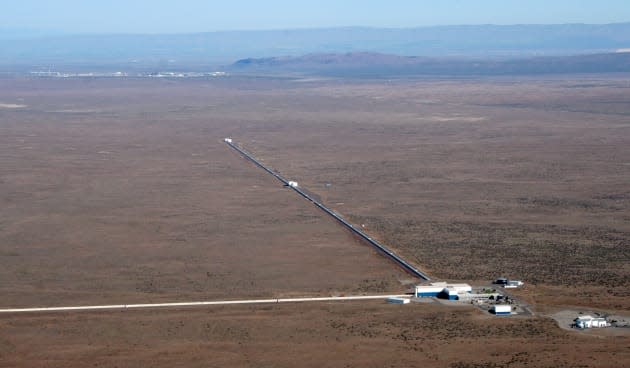Gravitational waves are our window into the early universe
This changes everything.

"We have detected gravitational waves. We did it," David Reitze, executive director of the Laser Interferometer Gravitational-Wave Observatory (LIGO), said at a press conference in Washington on Thursday. Reitze has good reason to be excited. LIGO's find is a huge, Nobel Prize-worthy accomplishment on par with CERN's discovery of the Higgs particle in 2012. Just as Higgs particles revolutionized the standard model of physics, gravitational waves are set to do the same to Einstein's theory of general relativity. Simply put, it will fundamentally alter how we view and interact with the universe around us.
Einstein actually predicted the existence of gravitational waves in his theory of general relativity just over 100 years ago, in 1915. In the general relativity model, as opposed to Newtonian mechanics, which stipulates that the macroscopic universe is static, gravity isn't just a weakly attractive force; it's the result of a curvature in the fabric of space-time generated by the mass of objects. Here's a quick visual demonstration:
As you can see in the video above, large objects with greater mass can bend space-time more than smaller, lighter ones. But when truly massive objects move around -- in this case, when a pair of black holes collide -- it will cause the fabric of space-time to scrunch up and then expand, moving outward at the speed of light like the ripples in the surface of a pond. That's what gravitational waves are -- ripples in the very fabric of the universe -- and what makes this discovery so momentous. We've been able to empirically and experimentally confirm many aspects of general relativity over the years. However, directly observing gravitational waves -- which lie at the heart of Einstein's theory -- has remained tantalizingly beyond our reach.
For more than a century, we've only been able to indirectly observe these waves, though it wasn't for lack of trying. The National Science Foundation has spent more than a billion dollars over the course of 50 years trying to observe this phenomenon, 25 of which were spent refining the instruments at LIGO's test sites in Washington State and Louisiana.

LIGO employs a pair of ludicrously sensitive 4-kilometer-long laser beams set up at right angles from each other, with a mirror at the end of each tube. As gravitational waves pass, the distance between the two mirrors shrinks then expands ever so minutely -- we're talking a thousandth the diameter of one atomic nucleus -- but that's enough for LIGO's detector to pick up. In fact, the confirming observation itself lasted just 20 thousandths of a second as a pair of distant supermassive black holes circled each other. As the black holes spiral closer, the space-time between them becomes increasingly distorted and generates increasingly stronger waves until they eventually coalesce into one and the distortions stop. This process creates the telltale "chirp" that LIGO detects. Researchers can calculate the wave-form of the chirp and from that determine the size of the two holes, their orientation relative to the observer and the manner in which they're orbiting each other.
"This is transformational," Birmingham University professor Alberto Vecchio, one of the researchers at LIGO, told the Guardian. "This observation is truly incredible science and marks three milestones for physics: the direct detection of gravitational waves, the first detection of a binary black hole, and the most convincing evidence to date that nature's black holes are the objects predicted by Einstein's theory."
This is huge not just because it validates one of the last unresolved bits of Einstein's theory of relativity; it could also very well allow us to manipulate the base layer of the physical universe. Just as our discovery of radio waves has led to modern mobile communications and has flat-out revolutionized astronomy by enabling researchers to see beyond the visible spectrum, the discovery of gravitational waves is going to change everything.
For example, astronomers currently can't observe the first 400,000 years of the Big Bang because the earliest years of the universe are impenetrable to light. Gravitational waves are a different story. "Literally, by gathering gravitational waves we will be able to see exactly what happened at the initial singularity," professor Neil Turok, director of the Perimeter Institute for Theoretical Physics in Waterloo, Canada, told the Guardian. "The most weird and wonderful prediction of Einstein's theory was that everything came out of a single event: the big bang singularity. And we will be able to see what happened."

